Saturday, July 16, 2005
Billon antoninianus, Gallienus, Rome, Göbl 358a
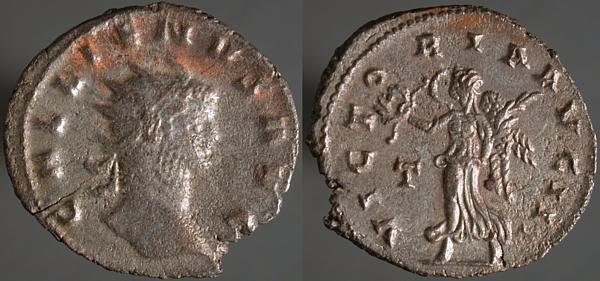
GALLIENVS AVG, Radiate head right | VICTORIA AVG III, Victory advancing left, raising wreath left, holding palm right. T in left field.
I have no doubt that Nike, whom the Romans adopted as Victoria, is the source for the conventional representation of angels.
Friday, July 15, 2005
Æ Tetradrachm, Alexandria, 255-256 CE, Gallienus, Emmett 3730(3)
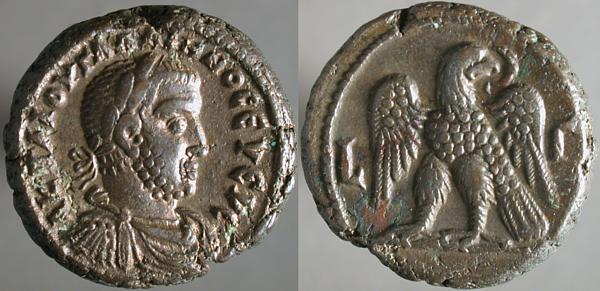
A K Π ΛI OV ΓAΛΛIHNOC EVEVC, Laureate draped cuirassed bust right | LΓ, Eagle standing left with wings spread, head right, wreath in beak. Regnal year across fields.
It's convenient, and traditional, to divide Roman coinage into Imperial, legal tender throughout the empire and Provincial, valid only in and around the city which issued it.
Roman Egypt, while usually considered a source of Provincial coins, is a bit different. From the time that Octavian took Egypt from Marc Antony and Cleopatra, Egypt was the personal property of the emperor. Roman Senators could not enter Egypt without the emperor's permission, and Imperial coins could not be spent. Exchange for Egyptian coins, at a profit to the emperor, was required, as was another exchange, and another profit, required when leaving Egypt.
Because the coins were officially valued well above their intrinsic (bullion) value there was no incentive to smuggle them out.
Thursday, July 14, 2005
Billon antoninianus, Valerian II, Rome, Göbl 250k
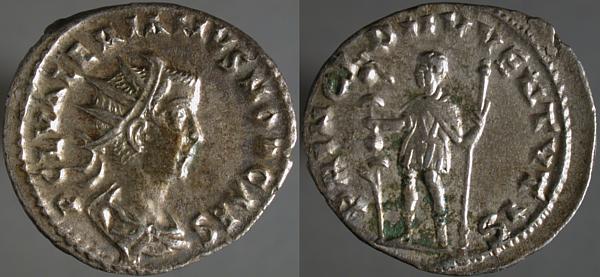
P C L VALERIANVS NOB CAES, Radiate draped cuirassed bust right | PRINCIPI IVVENTVTIS, Prince standing facing, head left, holding scepter right and standard left.
This coin lauds the young Valerian II, elder son of Gallienus, as the first of the youths, a traditional epithet for a young Caesar.
Valerian II would soon die and his younger brother Saloninus be made Caesar.
Wednesday, July 13, 2005
AR Tetartemorion, Kolophon in Ionia, c. 525-490 BCE, Sear Greek 4343
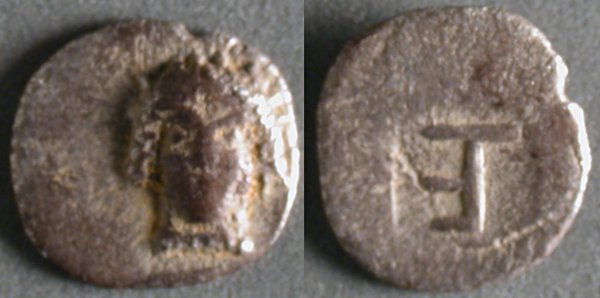
Head of Apollo facing | Retrograde TE monogram within incuse square.
Considerably older than most of my coins, this predates the wide adoption of token coinage for small change. At 0.17 grams, this tetartemorion was one of the smallest denominations issued and at 6.5mm at the widest, one of the physically smallest coins.
The Tetartemorion was 1/4th obol, and the obol 1/6th drachm. To over-generalize, a drachm was a day's pay for a skilled worker (and a tetartemorion 1/24th of that.)
Some collectors believe that these tiny coins were often carried in the mouth, in the absence of pockets.
Tough little things to get a decent photo of, tiny little coins, though Doug Smith pulled it off nicely.
Tuesday, July 12, 2005
Æ28, Metropolis in Ionia, Salonina, SNG Copenhagen 939
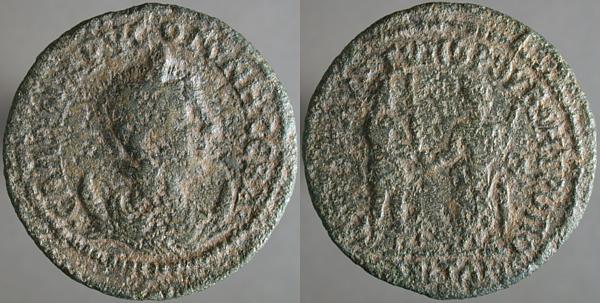
CAΛΩN XPV COP_NH CEB, Diademed draped bust right on crescent | METPOΛEITΩN EN IΩNIA, Hero left, leaning on spear and Boule right, holding scepter, facing and joining hands.
Boule here represents a ruling body of the city. Their power, in imperial times, would not have extended far from the city, and election to the body may have meant more responsibility, for financing festivals, &c, than any real authority.
Between Fritz Lang and Superman on one side and "Ephesus was the metropolis of Ionia", Google hasn't helped me learn much of what became of the real Metropolis in Ionia.
Monday, July 11, 2005
Billon antoninianus, Gallienus, Köln, Göbl 22d
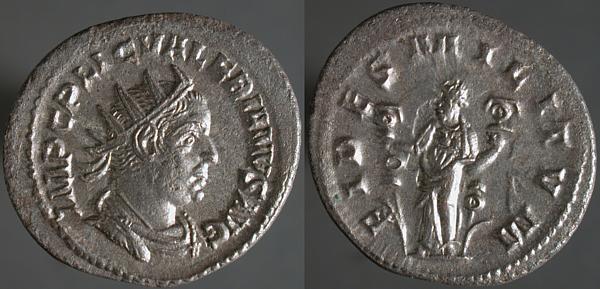
IMP C P LIC VALERIANVS AVG, Radiate draped cuirassed bust right | FIDES MILITVM, Fides standing facing, head left, holding a standard to either side.
A nicely-preserved example from the first emission of coins for the new emperor, advertising the loyalty of the army, without which no emperor would reign, or live, long.
Fides holds battle standards, objects of veneration by the legions. Near their bases a handle is visible, which the Aquilifer could hold with one hand to steady the standard while supporting it with the other.
Sunday, July 10, 2005
"one of the finest classical mosaics yet uncovered"
Via the Explorator mailing list, a Gallienus-era mosaic of Bellerophon, mounted on Pegasus, slaying a chimera has been discovered at Palmyra, all bearing a remarkable resemblance to St George and the dragon.
Æ26, Ptolemais-Ace in Phoenicia, Gallienus, Sear GIC 4625
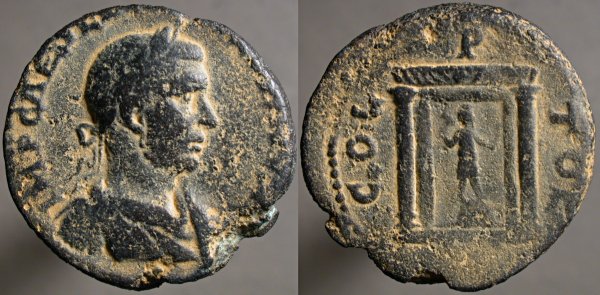
IMP CAES [P LIC GALLIENVS AVG], Laureate draped cuirassed bust right | COL P_TOL, Portable shrine consisting of frame within two pillars supporting architrave with hatched decoration; within, on base or altar, figure of a diety (Vulcan?) in short chiton, standing right holding bipennis or hammer left and harpa(?, tongs?) right.
I think it's Vulcan, Sear and the British Museum catalog take no position. Since I'm just a collector and not an academic, I have nothing to lose if a better example shows me to be wrong.
So I think it's Vulcan.

